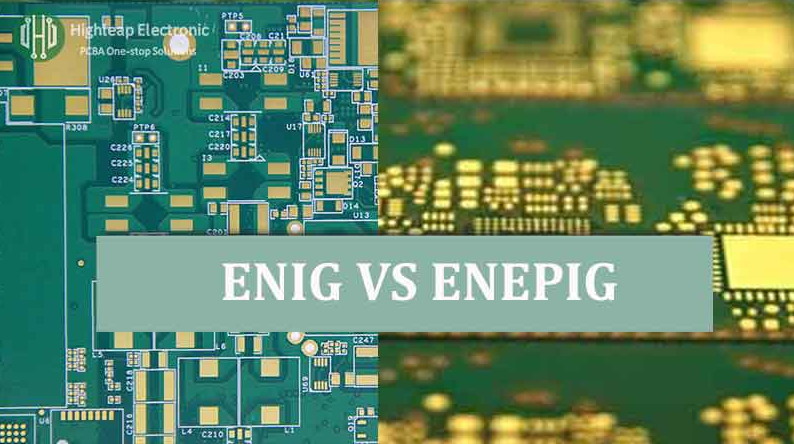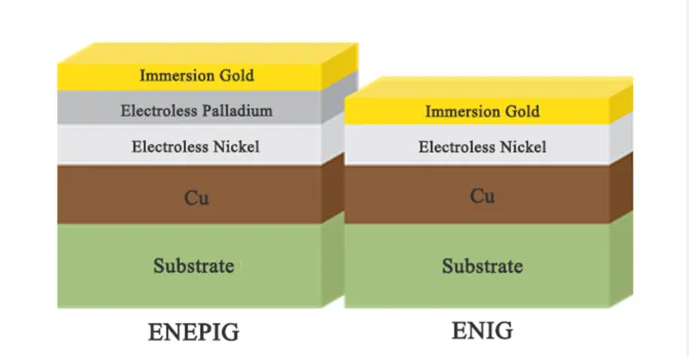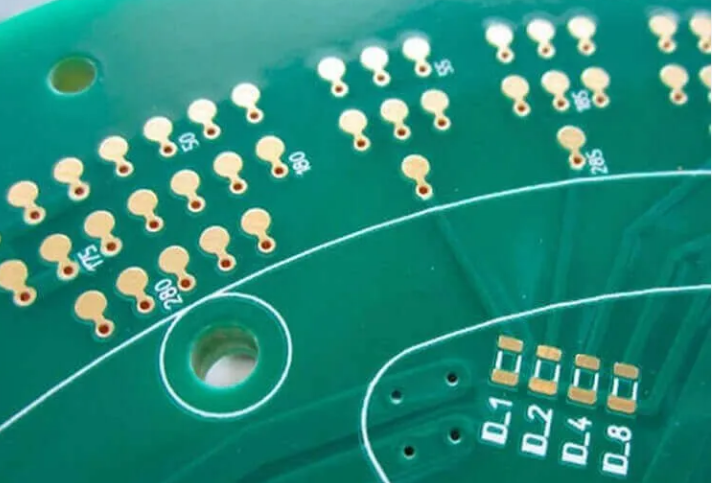If you're deciding between ENIG and ENEPIG for your PCB plating needs, you're likely looking for the best balance of reliability, cost, and performance. In short, ENIG (Electroless Nickel Immersion Gold) is a widely used, cost-effective surface finish with good solderability, while ENEPIG (Electroless Nickel Electroless Palladium Immersion Gold) offers superior reliability and versatility for advanced applications, though at a higher cost. This blog dives deep into the differences between these two finishes, covering advantages, applications, reliability, cost, and soldering performance to help you make an informed decision for your next project.
Introduction to PCB Surface Finishes
In the world of printed circuit board (PCB) manufacturing, surface finishes play a critical role in protecting the copper traces and ensuring reliable connections. A surface finish prevents oxidation, enhances solderability, and supports the overall performance of the PCB in various environments. Two popular choices for surface finishes are ENIG and ENEPIG. Both are widely used in modern electronics, but they serve different purposes depending on the project's requirements. In this comprehensive comparison, we'll explore how these finishes differ in terms of advantages, applications, reliability, cost, and soldering performance, with a focus on long-tail keywords like "ENEPIG PCB advantages," "ENEPIG applications," "ENIG PCB reliability," "ENEPIG vs ENIG cost," and "ENEPIG soldering performance."

What Are ENIG and ENEPIG?
Understanding ENIG (Electroless Nickel Immersion Gold)
ENIG is a two-layer surface finish consisting of a layer of nickel (typically 3-6 micrometers thick) applied through an electroless process, followed by a thin layer of immersion gold (around 0.05-0.1 micrometers). The nickel acts as a barrier to protect the underlying copper from oxidation, while the gold layer prevents the nickel from corroding and ensures excellent solderability. ENIG has been a popular choice since the 1990s due to its flat surface, compatibility with fine-pitch components, and suitability for lead-free soldering processes.
Understanding ENEPIG (Electroless Nickel Electroless Palladium Immersion Gold)
ENEPIG builds on the foundation of ENIG by adding a third layer of palladium (about 0.05-0.1 micrometers) between the nickel and gold layers. This palladium layer acts as an additional barrier, preventing the gold from corroding the nickel and eliminating the risk of a defect known as "black pad syndrome," which can occur in ENIG finishes. ENEPIG is often seen as an upgraded version of ENIG, offering enhanced reliability for demanding applications.

Key Differences Between ENIG and ENEPIG
While both finishes share a similar base structure, the addition of palladium in ENEPIG introduces significant differences in performance and application. Let's break down the comparison across critical factors like advantages, applications, reliability, cost, and soldering performance.
ENEPIG PCB Advantages vs. ENIG
When evaluating "ENEPIG PCB advantages," one of the standout benefits is its ability to prevent black pad syndrome. This defect, sometimes seen in ENIG, occurs when the nickel layer corrodes during the gold immersion process, leading to poor solder joint reliability. The palladium layer in ENEPIG acts as a shield, ensuring a robust connection. Additionally, ENEPIG offers excellent wire bonding capabilities, making it ideal for high-reliability applications like aerospace and medical devices. It also supports multiple reflow cycles without degrading, which is a significant advantage in complex assembly processes.
On the other hand, ENIG has its own strengths. It provides a flat, uniform surface for fine-pitch components, supports lead-free soldering, and is widely compatible with various assembly processes. While it may not match ENEPIG's advanced reliability features, ENIG remains a trusted choice for many standard applications due to its proven track record and lower cost.
ENEPIG Applications vs. ENIG Applications
Exploring "ENEPIG applications," this finish shines in industries where reliability is non-negotiable. It is commonly used in high-density interconnect (HDI) boards, advanced semiconductor packaging, and devices requiring gold wire bonding, such as those in aerospace, automotive, and medical sectors. The ability of ENEPIG to handle multiple reflow cycles and resist corrosion makes it suitable for environments with extreme temperature fluctuations or humidity levels.
ENIG, by contrast, is often applied in consumer electronics, telecommunications, and general-purpose PCBs. Its compatibility with surface-mount technology (SMT) and fine-pitch components makes it a go-to choice for smartphones, laptops, and other everyday devices. While it may not be the best fit for the most demanding applications, ENIG covers a broad range of needs effectively.
ENIG PCB Reliability Compared to ENEPIG
When discussing "ENIG PCB reliability," it's important to acknowledge that while ENIG is reliable for many applications, it has limitations. The potential for black pad syndrome can compromise solder joint integrity, especially in high-stress environments or after multiple reflow cycles. Studies have shown that ENIG can experience solder joint failure rates of up to 5% in extreme conditions due to nickel corrosion, though this varies based on manufacturing quality and environmental factors.
ENEPIG, however, offers superior reliability. The palladium layer prevents nickel corrosion, reducing the risk of solder joint failures to near zero under similar conditions. This makes ENEPIG a preferred choice for mission-critical applications where even a 1% failure rate is unacceptable. Its ability to maintain performance over extended periods and under harsh conditions further solidifies its position as a high-reliability finish.
ENEPIG vs ENIG Cost Analysis
One of the most significant factors in the "ENEPIG vs ENIG cost" debate is the price difference. ENIG is generally more cost-effective due to its simpler two-layer process. On average, ENIG finishes can cost around 10-20% less than ENEPIG, depending on the board size, volume, and specific manufacturing requirements. This makes ENIG an attractive option for budget-conscious projects or applications where extreme reliability isn't a primary concern.
ENEPIG, with its additional palladium layer, comes at a higher cost. The added material and processing steps increase the price, often making it 20-30% more expensive than ENIG. However, for projects where reliability and performance justify the expense, the investment in ENEPIG can save costs in the long run by reducing failure rates and extending the lifespan of the PCB.
ENEPIG Soldering Performance vs. ENIG
For "ENEPIG soldering performance," this finish excels in providing consistent and reliable solder joints. The palladium layer ensures that the nickel remains protected during the soldering process, resulting in stronger bonds and better performance across multiple reflow cycles. ENEPIG can withstand up to 5-7 reflow cycles without significant degradation, making it ideal for complex assemblies that require repeated soldering.
ENIG also offers good soldering performance, with excellent wettability for lead-free solders and compatibility with SMT processes. However, its performance can degrade after 3-4 reflow cycles, and the risk of black pad syndrome can lead to weaker solder joints in some cases. For standard applications, ENIG's soldering capabilities are more than adequate, but it may fall short in more demanding scenarios compared to ENEPIG.
Choosing Between ENIG and ENEPIG for Your PCB Project
Deciding between ENIG and ENEPIG depends on your project's specific needs. Here's a quick guide to help you choose:
- Choose ENIG if: You're working on a cost-sensitive project with standard reliability requirements, such as consumer electronics or general-purpose PCBs. ENIG offers a proven, affordable solution with good solderability and compatibility with most assembly processes.
- Choose ENEPIG if: Your project demands high reliability, involves wire bonding, or will be exposed to harsh environments. ENEPIG is the better choice for aerospace, medical, or automotive applications where failure is not an option.
Consider factors like budget, environmental conditions, and the expected lifespan of your product. For instance, if your PCB will operate in a high-humidity environment with temperature swings from -40°C to 85°C, ENEPIG's enhanced corrosion resistance could be worth the extra cost. On the other hand, for a simple device operating in controlled conditions, ENIG will likely suffice.
Manufacturing Considerations for ENIG and ENEPIG
Both ENIG and ENEPIG require precise manufacturing processes to ensure quality. For ENIG, controlling the thickness of the gold layer is critical—too thin, and it may not protect the nickel; too thick, and it can increase costs unnecessarily. Typical gold thickness for ENIG ranges from 0.05 to 0.1 micrometers, while nickel thickness should be between 3 and 6 micrometers to provide a robust barrier.
For ENEPIG, the palladium layer's uniformity is essential to prevent defects. Manufacturers must carefully monitor the deposition process to ensure the palladium layer falls within the 0.05 to 0.1 micrometer range. Any inconsistency can compromise the finish's ability to prevent corrosion or support wire bonding.

Conclusion: Making the Right Choice for Your PCB Plating
Both ENIG and ENEPIG offer distinct benefits as PCB surface finishes, and the right choice depends on your project's unique requirements. ENIG provides a cost-effective, reliable option for standard applications, with excellent solderability and compatibility with modern assembly techniques. ENEPIG, with its added palladium layer, delivers unmatched reliability, corrosion resistance, and performance in demanding environments, making it ideal for high-stakes industries.
By understanding the differences in advantages, applications, reliability, cost, and soldering performance, you can select the finish that best aligns with your needs. Whether you're prioritizing "ENEPIG PCB advantages" for a cutting-edge medical device or focusing on "ENIG PCB reliability" for a consumer product, this comparison equips you with the knowledge to make an informed decision. At ALLPCB, we're committed to supporting your projects with high-quality surface finishes tailored to your specifications, ensuring optimal performance for every board.
 ALLPCB
ALLPCB







